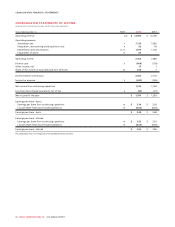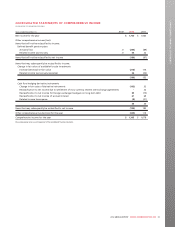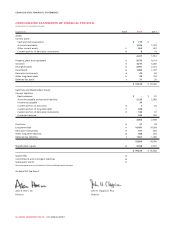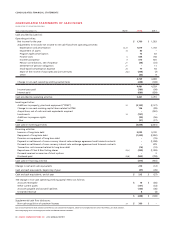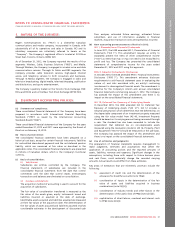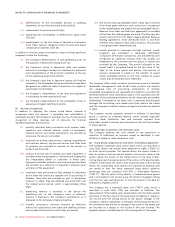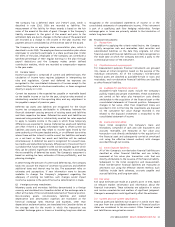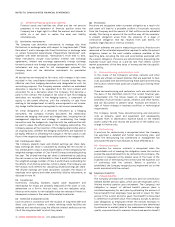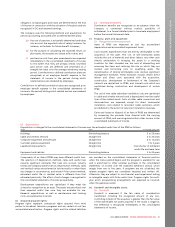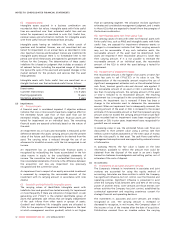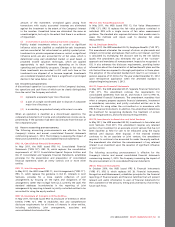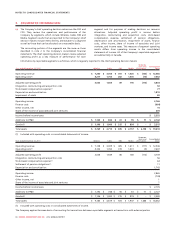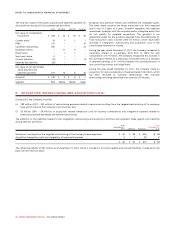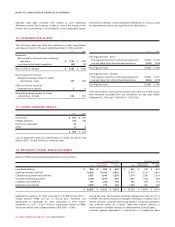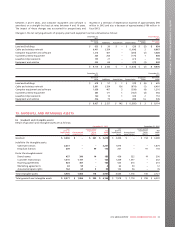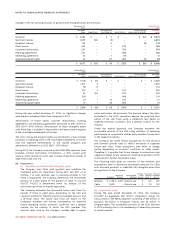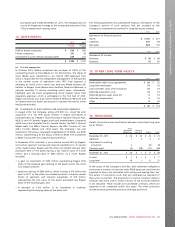Rogers 2012 Annual Report Download - page 95
Download and view the complete annual report
Please find page 95 of the 2012 Rogers annual report below. You can navigate through the pages in the report by either clicking on the pages listed below, or by using the keyword search tool below to find specific information within the annual report.
NOTES TO CONSOLIDATED FINANCIAL STATEMENTS
obligation. Actuarial gains and losses are determined at the end
of the year in connection with the valuation of the plans and are
recognized in OCI and retained earnings.
The Company uses the following methods and assumptions for
pension accounting associated with its defined benefit plans:
(a) the cost of pensions is actuarially determined and takes
into account the expected rates of salary increases, for
instance, as the basis for future benefit increases;
(b) for the purpose of calculating the expected return on
plan assets, those assets are valued at fair value; and
(c) past service costs from plan amendments are expensed
immediately in the consolidated statements of income
to the extent that they are already vested. Unvested
past service costs are deferred and amortized on a
straight-line basis over the average remaining vesting
period. Contributions to defined contribution plans are
recognized as an employee benefit expense in the
statement of income in the periods during which
related services are rendered by employees.
Contributions to defined contribution plans are recognized as an
employee benefit expense in the consolidated statements of
income in the periods during which related services are rendered
by employees.
(ii) Termination benefits:
Termination benefits are recognized as an expense when the
Company is committed without realistic possibility of
withdrawal, to a formal detailed plan to terminate employment
before the normal retirement date.
(r) Property, plant and equipment:
(i) Recognition and measurement:
Items of PP&E are measured at cost less accumulated
depreciation and accumulated impairment losses.
Cost includes expenditures that are directly attributable to the
acquisition of the asset. The cost of self-constructed assets
includes the cost of materials and direct labour, any other costs
directly attributable to bringing the assets to a working
condition for their intended use, the costs of dismantling and
removing the items and restoring the site on which they are
located, and borrowing costs on qualifying assets. The
determination of directly attributable costs involves significant
management estimates. These estimates include certain direct
labour and direct costs associated with the acquisition,
construction, development or betterment of the Company’s
network are capitalized to PP&E, and interest costs which are
capitalized during construction and development of certain
PP&E.
The cost of new cable subscriber installation costs are capitalized
to cable and wireless network and is depreciated over the useful
lives of the related assets. Costs of other cable connections and
disconnections are expensed, except for direct incremental
installation costs related to reconnect Cable customers, which
are deferred to the extent of reconnect installation revenues.
Gains and losses on disposal of an item of PP&E are determined
by comparing the proceeds from disposal with the carrying
amount of PP&E, and are recognized within other income in the
consolidated statements of income.
(ii) Depreciation:
Depreciation is charged to the consolidated statements of income over the estimated useful lives of the PP&E as follows:
Asset Basis Estimated useful life
Buildings Diminishing balance 5 to 25 years
Cable and wireless network Straight-line 3 to 30 years
Computer equipment and software Straight-line 4 to 10 years
Customer premise equipment Straight-line 3 to 5 years
Leasehold improvements Straight-line Over shorter of estimated
useful life and lease term
Equipment and vehicles Diminishing balance 3 to 20 years
Components of an item of PP&E may have different useful lives.
The selection of depreciation methods, rates, and useful lives
requires significant estimates that take into account industry
trends and company-specific factors. Depreciation methods, rates
and residual values are reviewed at least annually or when there
are changes in circumstances, and revised if the current method,
estimated useful life or residual value is different from that
estimated previously. The effect of such changes is recognized in
the consolidated statements of income prospectively.
Development expenditures are capitalized if they meet the
criteria for recognition as an asset. The assets are amortized over
their expected useful lives once they are available for use.
Research expenditures, as well as maintenance and training
costs, are expensed as incurred.
(s) Acquired program rights:
Program rights represent contractual rights acquired from third
parties to broadcast television programs and are carried at cost less
accumulated amortization. Program rights and the related liabilities
are recorded on the consolidated statements of financial position
when the licence period begins and the program is available for use
and is amortized to other external purchases in the consolidated
statements of income over the expected exhibition period, which
ranges from one to five years. If programs are not scheduled, the
related program rights are considered impaired and written off.
Otherwise, they are subject to non-financial asset impairment testing
as intangible assets with finite useful lives. Program rights for multi-
year sports programming arrangements are expensed as incurred,
when the games are aired.
(t) Goodwill and intangible assets:
(i) Goodwill:
Goodwill is measured if the fair value of consideration
transferred, including the recognized amount of any non-
controlling interest of the acquiree, is greater than the fair value
of the identifiable net assets acquired. If the excess is negative,
the difference is recognized immediately in the consolidated
statements of income.
2012 ANNUAL REPORT ROGERS COMMUNICATIONS INC. 91



